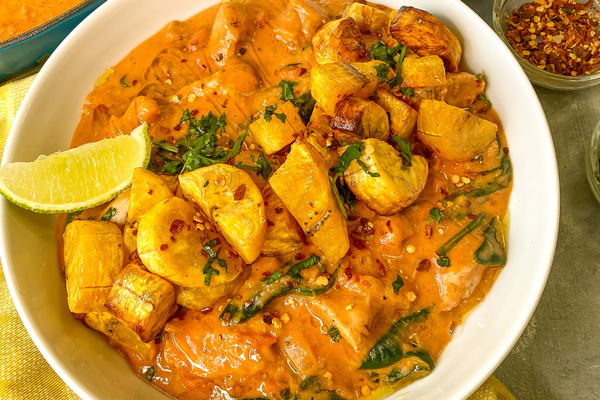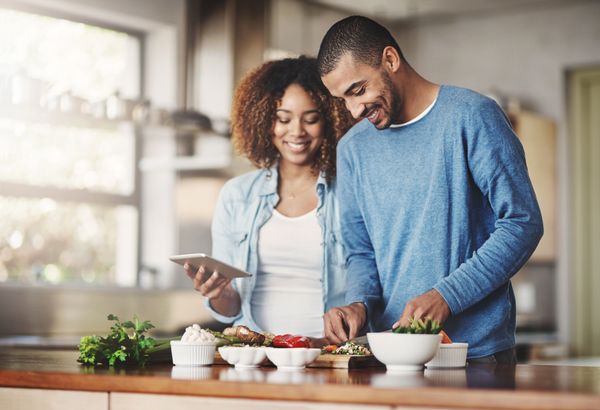With Thanksgiving being the traditional kickoff to the holiday season, the time can be filled with love, laughter and good company. But it can also be filled with calories and a temporary pass on good health habits.
"Oh, it's the holidays—let me eat what I want and worry about it later," is the stuff that fuels the New Year's resolutions' bottomless tank.
If you don't want to start the holidays on the wrong foot or with too many calories under your belt, you can enjoy them and keep to your healthy eating habits.
We've reached out to the people who know—seven of the best registered dietitians around—for their advice. Here are some ways you can have your turkey without feeling like a stuffed bird.
From Amy Gorin, RDN, owner of Amy Gorin Nutrition
- Have veggie fun. There's always so much delicious food to eat, but some of it can be pretty decadent. I like to encourage everyone to fill up on crudité as an appetizer. Here's my recipe for a Turkey Veggie Tray. It's super easy to make, and I serve it with hummus and guacamole.
- Go for mini sweets. Thanksgiving was always a huge holiday in my house growing up, and my mom and I would cook for days to prepare for the crowd. One of the staples on our Thanksgiving menu were mini Cinnamon Spice Muffins. I love how they're portion controlled. (My healthy version uses whole-wheat flour to boost the fiber and plain Greek yogurt to decrease the butter content.)
From Natalie Rizzo, RD, Nutrition à la Natalie
- Embrace seasonal produce. We tend to think of Thanksgiving as a time when you eat turkey, stuffing and mashed potatoes, but there's so much healthy (and non-starchy) produce in season. Embrace this abundance by featuring things like different types of squash, leafy greens, pumpkin, apples, pears, cranberries and pomegranates. Make a side dish that feels like Thanksgiving but has a healthier twist, and make the seasonal produce the star of the show.
- Ask yourself if it's worth it. I absolutely think you should eat your favorite treats on Thanksgiving. If you look forward to stuffing or pumpkin pie all year long, then please feel free to indulge. But certain foods really aren't that special, and you shouldn't waste your calories or appetite on eating them—like cheese and crackers or frozen pastry puffs. Instead, ask yourself if this food is special to you and it's worth eating. If the answer is yes, then go ahead and pick up a fork!
From Marisa Moore, RDN, Marisa Moore Nutrition
- Preload. Start your holiday meal with vegetables and a couple of slices of chicken or turkey breast, then go light on more indulgent dishes like stuffing or dressing, casseroles and candied yams.
- Put out healthy snacks. Set small bowls of oranges or tangerines in the sitting and dining areas for guest to enjoy while they chat before dinner. Or, buy plain, roasted or seasoned walnuts (cinnamon spice, rosemary or salt-and-pepper varieties are nice this time of year) and arrange on a plate or in small ramekins. The walnuts provide a dose of healthy fat, fiber and protein.
From Jill Weisenberger, RDN, author of The Overworked Person's Guide to Better Nutrition
- Leave it alone if it doesn't scream Thanksgiving. There will be tons to choose from, and it can be tempting to dig into it all. But chances are a lot of it will be everyday fare and not special holiday food. Leave the cheese and crackers behind (you can have those anytime) and, instead, hold off to enjoy the stuffing, gravy, cranberry sauce and a slice of pie—those foods that you rarely eat and mean something special to you.
- Modify. If you're the cook, alter your favorite recipes by trimming sugar, using olive or canola oils instead of butter and adding extra veggies to stuffing, mac and cheese or any dish that can handle it. If you're the guest, offer to bring a healthful dish to share.
From Jackie Mills, RDN, culinary communications consultant
- Indulge—just a little—and enjoy. The holiday only comes once a year—and if you usually eat a healthy diet, this is a good day to savor a drizzle of gravy, a scoop of potato casserole and a small slice of pecan pie. Enjoy the day and be grateful for the abundance of delicious food and the treasure of time spent with family and friends.
- Showcase your veggie know-how. There's a bounty of fresh vegetables right now: greens like kale, collards and Swiss chard; winter squashes like butternut, kabocha and delicata; root veggies like turnips, beets, parsnips and carrots; and so much more. Take advantage of these healthy and seasonal vegetables that taste amazing and can be prepared with ease.
From Bonnie Taub-Dix, RDN, creator of BetterThanDieting.com and author of Read It Before You Eat It
- Snack first—but snack right. Eat a well-rounded snack before going into a Thanksgiving dinner. If you're starving when you sit down at the table, you'll most likely eat beyond full. Greek yogurt, almond butter on a piece of toast or a bowl of cereal and milk will all provide a combo of protein and carbs to keep you feeling fuller longer.
- Keep the word "sample" in mind. Try little tastes of special foods—even if they're rich and high in calories. The key word here is "little." You won't suffer guilt or become upset with yourself the next day!
From Victoria Retelny, RDN, The Lifestyle Nutritionist and author of Total Body Diet for Dummies and The Essential Guide to Healthy Healing Foods
- Use herbs and spices in place of salt. Rub a turkey breast with smoked paprika, sage and extra-virgin olive oil; mince fresh tarragon into stuffing; blend minced garlic cloves into mashed potatoes; sprinkle turmeric powder into sweet potatoes.
- Watch your liquid calories. Alcohol and sugar mixtures can all add up. Instead, make "mocktails" with a mix of sparkling water, a splash of juice, garnished with a slice of fresh fruit. Instead of a full glass of wine, make it half wine and half sparkling water.
From Kelly Kennedy, RD
- Don't forget to drink your water. The centers in the brain that process the feelings of hunger and thirst are very close together, so it's not uncommon for someone who is thirsty to feel like they're hungry when they really aren't. Staying well hydrated throughout the day and drinking a big glass of water about 30 minutes before the meal is served is a good way to help your body sense when you are truly full. Substitute water or seltzer for cocktails (or at least in an alternating pattern with alcoholic beverages)—another great way to cut back on extra calories.
- Bring your own. One of the main complaints that I get is that there's "nothing healthy" at the party, so people tend to go "all in." Knowing that there is at least one healthy dish that you can use as the main part of your meal and then have other favorites on the side is a great compromise and healthy plan while still enjoying some of your favorites in moderation.







